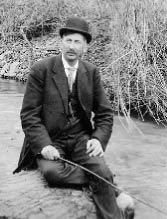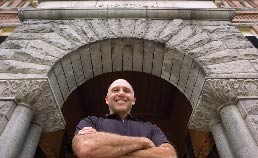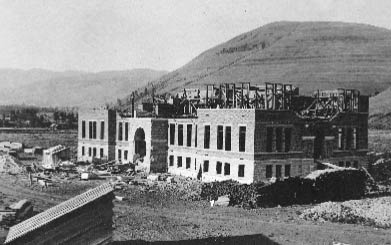A Monumental Man
Rafael Chacón examines A.J. Gibson’s contributions to Montana architecture
By Patia Stephens

“The Gibsons made their mark in this part of the West during an exciting period in American history. Their story reflects not only their personal virtues and shortcomings, but also the values and hopes shared by many at the turn of the twentieth century.”
– Hipólito Rafael Chacón in The Original Man: The Life and Work of Montana Architect A.J. Gibson
When UM art history and art criticism Professor Hipólito Rafael Chacón began researching architect Albert John Gibson in 2002, there were fifty-six buildings attributed to Gibson, including forty-four in Missoula. By the time he published his new book, The Original Man: The Life and Work of Montana Architect A.J. Gibson, six years later, Chacón had documented 144 Gibson designs and ninety completed buildings.
A.J. Gibson’s architectural legacy is remarkable for a man who was both self-taught and active in his field for only eighteen years.
“He was a great designer and a great craftsman,” Chacón says. “It’s almost a Horatio Alger story—that an individual with a sixth-grade education could achieve what he achieved in such a short period of time. I think it speaks to what was possible in Montana in that age.”
Chacón’s work—tracing Gibson’s life story and uncovering nearly three dozen additional buildings designed by him—also is quite an accomplishment. The biography is as much a record of Gibson’s architecture as it is a chronicle of Missoula’s early history—and of the enduring love affair between A.J. and his wife, Maud.
Gibson left his native Ohio for Montana in 1883, landing in the booming city of Butte, where the young carpenter spent five years practicing his trade and growing his skills as a contractor and architect. It was also in Butte that he met the educated young lady who would become his bride, Maud Lockley.
The couple married and settled in the thriving frontier town of Missoula in 1889. While A.J. rose to prominence as the area’s premier architect, Maud chronicled his career and their family life in photographs and scrapbooks.
“They say that behind every great artist there’s a great wife or great spouse,” Chacón says. “Maud clearly supported A.J. and encouraged him. She had chutzpah. She was a real live wire. She was also an excellent photographer.”
It is from Maud’s scrapbooks, as well as A.J.’s architectural drawings—which had been hidden in UM’s Mansfield Library archives since being narrowly rescued from a Dumpster—that Chacón put together the pieces of Gibson’s life and work.
The Original Man is published by The University of Montana Press and the Montana Museum of Art & Culture, an appropriate choice given Gibson’s close association with UM. He designed the first five buildings on campus, beginning with University Hall—popularly known as Main Hall—and Science Hall. Completed in 1898, just five years after the University’s charter, the two Romanesque Revival buildings were Gibson’s biggest commissions to date. Set against the backdrop of Mount Sentinel, Main Hall remains the beloved and picturesque centerpiece of campus.

Hipólito Rafael Chacón, professor of art and art historian at UM, penned The Original Man: The Life and Work of Montana Architect A.J. Gibson.
Science Hall and a gymnasium Gibson designed have since been demolished, but his Women’s Hall and library live on as the Math Building and Jeannette Rankin Hall, respectively. The structures are a mix of Renaissance and Neoclassical Revival styles.
Gibson is responsible for dozens of public, residential, and commercial buildings in the region, from one-room schoolhouses to grand mansions. The best-known include the Missoula County Courthouse, the Marcus Daly Mansion in Hamilton, and the Missoula Art Museum (formerly the Carnegie Public Library). His designs incorporated everything from Queen Anne to Spanish Mission styles.
“He’s what we would call a Revival architect,” Chacón says. “He worked in a number of different styles. He was able to stay abreast of the style that was of national importance and bring that style to Western Montana.”
Chacón spent hours scouring county records, city directories, old maps, and Gibson’s architectural drawings, as well as knocking on doors, to document the ninety buildings listed in his book’s appendices.
Occasionally, discoveries practically fell in his lap. In the early stages of his research, Chacón was driving down Higgins Avenue when he passed a construction project under way on a business between Third and Fourth streets.
“They were pulling off the wooden false façade and uncovering the original brickwork,” says Chacón, who immediately recognized Gibson’s distinctive style. “I thought, ‘That looks familiar,’ and ran to the Mansfield archives and found the blueprint.”

Main Hall, which was designed by Gibson, as it was built.
In his fourteen years at UM, Chacón has been an active leader in historic preservation efforts on campus and in the state. He has served three terms each on the Missoula Historic Preservation Commission and the Montana State Historic Preservation Office review board, which makes recommendations to the National Register of Historic Places.
“Montana has such a rich legacy,” he says. “It’s important to preserve the buildings, the places where history happened.”
He’s been involved in efforts to save historic buildings on campus and off, and works to ensure remodels are done with care and sensitivity to the past.
“The big challenge on campus is, how do you take these historic structures and balance our desire to see them in a historic context with their current and future needs?” says Chacón, who also serves on the Campus Arboretum Committee. “Every tree and every stone on this campus has a connection to history. In my mind, this is holy ground. We have to be very intentional about how we use the precious ground that we have.”
Asked whether he believes the ghost stories often told about Main Hall, Rankin Hall, and other campus buildings, Chacón laughs and says no.

“But there were times when I was doing this research, reconstructing the lives of A.J. and Maud Gibson, when I almost lost myself in their world. Some of these buildings do evoke the ghosts of the past; you do sense the presence of the people who have inhabited them.”
A.J. Gibson retired young, at age forty-six in 1909, and he and Maud spent nearly twenty more years having the time of their lives. In 1902, they had bought only the third automobile in Missoula County, and they traveled as far away as California and New York during a time when horses were still the main form of transportation. The couple also enjoyed camping and visiting with family and friends, who included the Reverend John Maclean and his wife and sons, Paul and Norman, who later wrote A River Runs Through It.
The Gibsons’ love of automobile travel was ultimately their tragic undoing. On New Year’s Eve in 1927, A.J. and Maud were killed instantly when a train hit their car at a crossing on Dakota Street. They are buried in the Missoula City Cemetery.
While A.J. Gibson’s legacy lives on in his many buildings, he and his wife have finally received their due recognition in Chacón’s book, The Original Man.
“It’s a very rich history of a very interesting life,” Chacón says. “Those guys had a lot of fun, he and Maud.”
![]() Patia Stephens ’00, M.F.A. ’07 is a freelance writer in Missoula. She worked for UM as an editor and Web content manager for ten years in University Relations. Visit her Web site at www.patiastephens.com.
Patia Stephens ’00, M.F.A. ’07 is a freelance writer in Missoula. She worked for UM as an editor and Web content manager for ten years in University Relations. Visit her Web site at www.patiastephens.com.